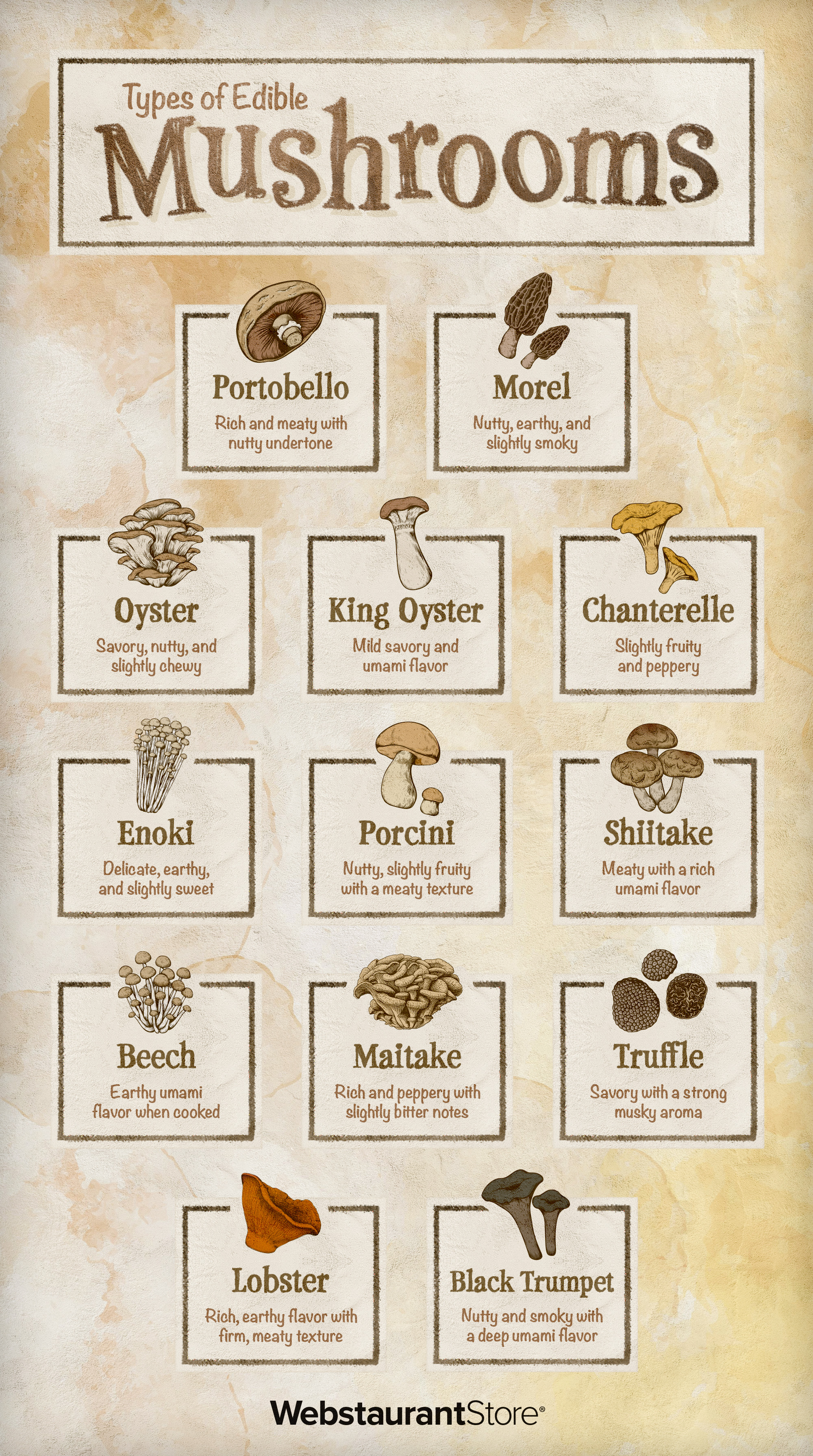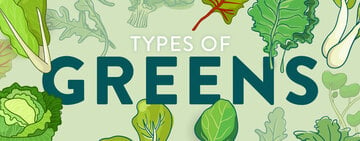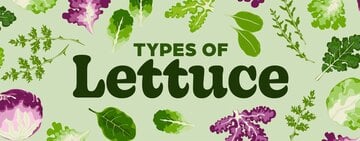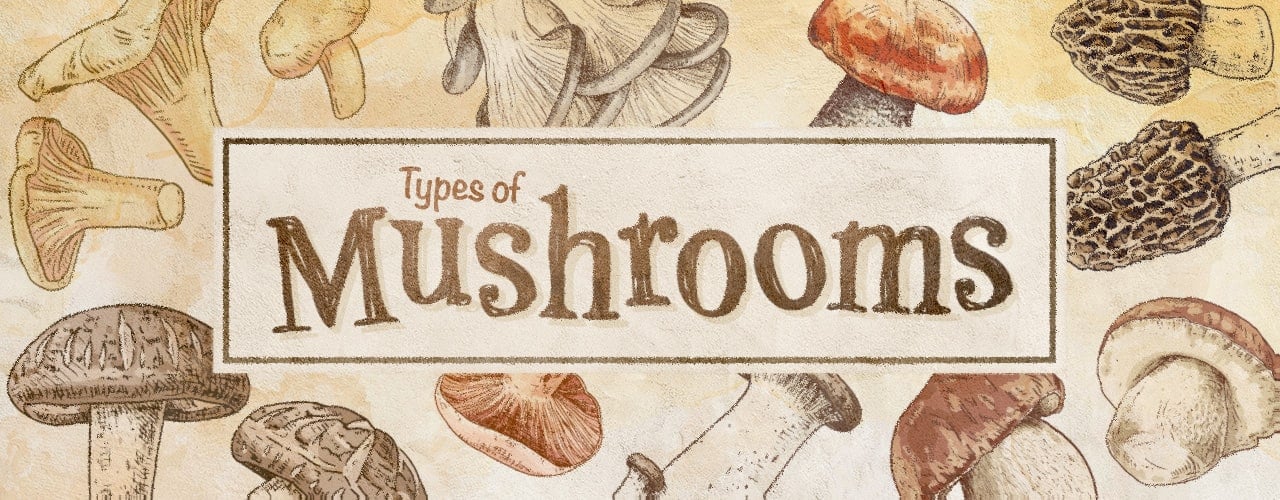
Mushrooms are a diverse ingredient that can add unique flavors and textures to your specialty dishes. With over 10,000 different types of mushrooms, they come in a wide range of shapes, sizes, and colors. From the popular portobello varieties to the exotic shiitake mushrooms, each type of mushroom has its own distinct taste and culinary applications. Whether you're looking to add a savory umami flavor to soups and stir-fries or create a nutrient-rich vegetarian alternative, mushrooms offer endless possibilities for commercial kitchens.
Shop All MushroomsWhat Is a Mushroom?
Mushrooms are a type of fungi that come in various shapes, sizes, and colors. They are unique organisms that reproduce through spores and thrive in diverse environments. Mushrooms can be found in forests, grasslands, and even on decaying logs. While some mushrooms are edible and used in culinary dishes, others are poisonous and can be harmful if ingested. Because of this, it is important to purchase your mushrooms from a reputable source and not wild forage them without clear guidance. Even edible mushrooms can contain carcinogenic compounds like hydrazine. It is essential to thoroughly cook mushrooms so the potential toxins can be neutralized.
Types of Mushrooms
We explore some of the most popular types of edible mushrooms below so you can find the right ones for your menu:
1. Portobello Mushrooms
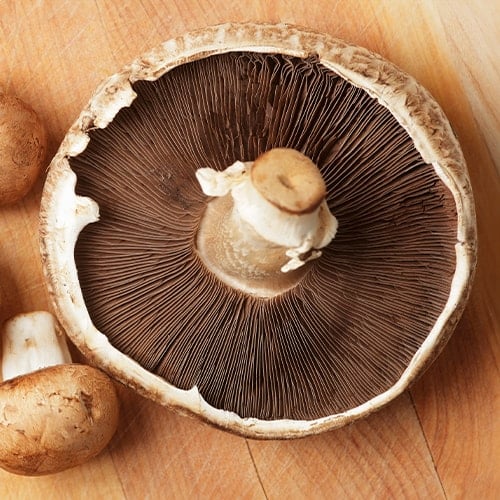
Portobello mushrooms (Agaricus bisporus), also known as portabella or portabello mushrooms, are a popular choice among chefs and are used throughout their growing stages. Despite their different names, white button mushrooms, cremini mushrooms, cup mushrooms, flat mushrooms, and Swiss brown mushrooms are all portobello mushrooms at different maturity levels. These large, meaty mushrooms have a rich, earthy flavor and a firm texture, making them a versatile ingredient in various dishes. Portobello mushrooms are often used as a meat substitute in vegetarian and vegan recipes, thanks to their substantial size and hearty taste.
- What Do Portabello Mushrooms Look Like? Smooth and slightly convex dark brown cap with gills underneath on top of a sturdy white stem
- What Do Portobello Mushrooms Taste Like? Rich and meaty flavor with hints of earthiness and a slightly nutty undertone
- How to Use Portobello Mushrooms: Grilled, roasted, sauteed, or stuffed; commonly used in burgers, sandwiches, salads, and pasta dishes
- How to Clean Portobello Mushrooms: Remove the stem and discard. Gently wipe the cap with a damp paper towel or brush to remove any dirt or debris. Scrape out the gills and discard. Avoid soaking the mushrooms in water, as they can become waterlogged and lose their flavor.
Portobello Mushroom Varieties
The following are the different names you may see portobello mushrooms listed as at their different growing stages:
- White Button Mushrooms: Also called common mushrooms, these are the youngest and smallest size of portobello mushrooms. With a mild flavor, button mushrooms are widely used in culinary applications due to their ability to absorb flavors.
- Cremini Mushrooms: Often referred to as baby bellas, cremini mushrooms are a slightly more mature version of white button mushrooms. They can also grow in a tan color and be labeled as Swiss brown mushrooms but are still portobello mushrooms in the second stage of growth. They have a firmer texture and a deeper, earthier flavor compared to white button mushrooms.
- Flat Mushrooms: Just before full maturity, portobello mushroom caps begin to open and can be labeled as flat mushrooms or open-cap mushrooms. Their caps can be roasted, stuffed, or sauteed to enhance their flavor.
- Portobello Mushroom: The largest and most mature version of the Agaricus bisporus mushroom family, portobello mushrooms are known for their meaty texture and robust flavor, making them a popular choice for grilling, stuffing, and serving as a meat substitute.
2. Morel Mushrooms
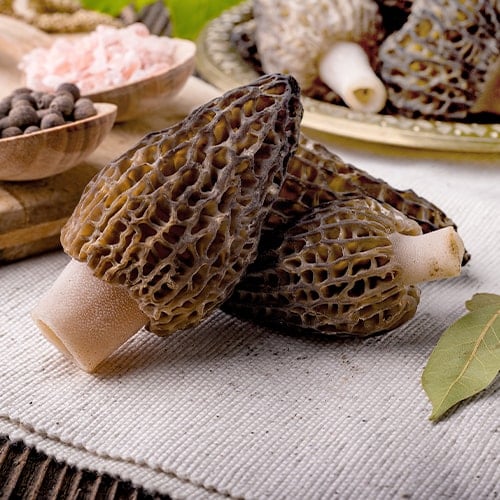
Morel mushrooms (Morchella) have a unique appearance with a honeycomb-like cap and hollow stem. They are highly sought after by chefs for their distinctive nutty and earthy flavor for dishes like pasta, risotto, and sauces. Morel mushrooms are commonly sauteed or roasted to enhance their rich flavor profile. They will typically have a high price point and are considered a gourmet ingredient in the culinary world due to their eye-catching honeycomb appearance. When using morel mushrooms in your recipes, it's important to cook them thoroughly to neutralize any potential toxins present in the raw mushroom.
- What Do Morel Mushrooms Look Like? Cone-shaped cap that is pitted with a distinctive honeycomb-like texture and hollow stems
- What Do Morel Mushrooms Taste Like? Nutty, earthy, and slightly smoky with a hint of sweetness
- How to Use Morel Mushrooms: Sauteed for toppings or sides, in soups, sauces, gravies, stuffing, and risotto
- How to Clean Morel Mushrooms: Trim off any tough or dirty ends. Gently brush the mushrooms with a soft brush or cloth to remove any debris. To remove any hidden grit, soak the mushrooms in a bowl of cold water for five minutes, then rinse and pat them dry.
3. Oyster Mushrooms
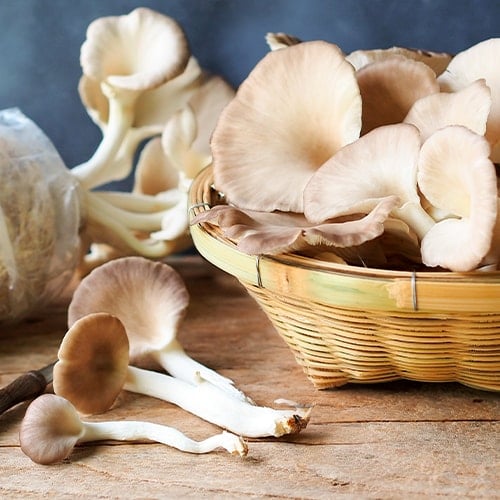
Oyster mushrooms (Pleurotus ostreatus) are named for their resemblance to oyster shells. These mushrooms come in various colors, including white, gray, and pink, and feature a distinctive fan-like shape. With a mild, slightly nutty taste, oyster mushrooms can be sauteed, grilled, and stir-fried. Oyster mushrooms also pair well with other ingredients such as garlic, thyme, butter, and white wine. Their ability to absorb flavors during cooking makes them a popular choice for marinating or seasoning with herbs and spices.
- What Do Oyster Mushrooms Look Like? Fan-shaped caps and short, stubby stems, ranging in color from white to gray, brown, or even pink
- What Do Oyster Mushrooms Taste Like? Earthy and slightly nutty; when cooked, they develop a rich, savory taste and slightly chewy bite
- How to Use Oyster Mushrooms: Sauteed for soups, salads, and pasta, grilled for entree sides
- How to Clean Oyster Mushrooms: Gently brush off any dirt with a damp paper towel or soft brush. Avoid soaking in water as they can become waterlogged and lose their delicate flavor. If needed, rinse quickly under cold running water and pat them dry with a paper towel.
4. King Oyster Mushrooms
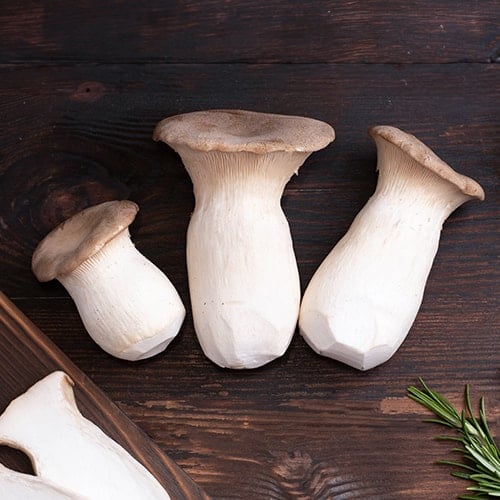
King oyster mushrooms (Pleurotus eryngii), also known as king trumpet mushrooms, have thick white stems, small brown caps, and a meaty texture. With a mild nutty flavor, they are a popular choice for adding depth and umami to a variety of dishes in commercial kitchens, absorbing flavors as they cook. King oyster mushrooms feature a visually appealing cross-section when cut which enhances the overall culinary presentation of the meal. King oyster mushrooms are often used in stir-fries and soups, as well as a meat substitute in vegan and vegetarian dishes.
- What Do King Oyster Mushrooms Look Like? Thick ivory-white stem with a small brown cap on top, flared out like a trumpet
- What Do King Oyster Mushrooms Taste Like? Mild and savory flavor profile with a subtle umami taste which intensifies when cooked
- How to Use King Oyster Mushrooms: Marinated then grilled, roasted, or sauteed for appetizers, salads, and stir-fries
- How to Clean King Oyster Mushrooms: Trim the ends of the stems. Wipe with a damp paper towel to remove dirt or debris. Do not soak. Instead, give them a quick rinse if needed and pat dry.
Oyster vs King Oyster Mushroom
Although they have similar names, oyster mushrooms and king oyster mushrooms are not the same. Oyster mushrooms have a fan-like shape while king oyster mushrooms are more trumpet-like in appearance. Oyster mushrooms have a delicate, mild taste and a soft, velvety texture, while king oyster mushrooms have a meaty texture and a rich, umami flavor.
5. Chanterelle Mushrooms
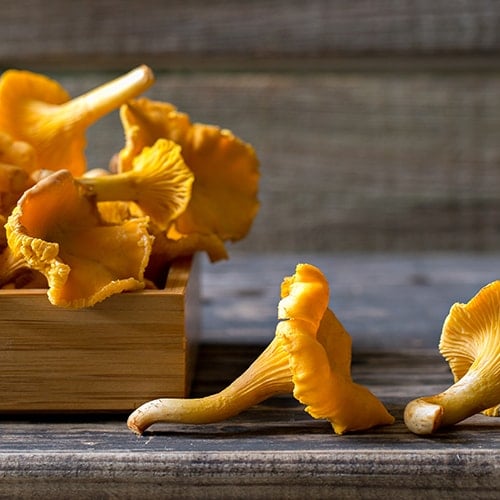
Chanterelle mushrooms (Cantharellus cibarius) are prized for their fruity, apricot aroma, vibrant color, and nutty flavor. These mushrooms have a distinctive golden color and a funnel shape with ridges on the underside instead of traditional gills. Chanterelles are commonly used in upscale restaurants and culinary applications due to their unique taste and texture. They can be sauteed, roasted, or used as a topping for pizzas and omelets for a gourmet touch. Chanterelle-infused sauces are also commonly used to complement poultry, pork, or seafood dishes. Pickled chanterelles make a tangy and flavorful addition to salads, charcuterie boards, or sandwiches.
- What Do Chanterelle Mushrooms Look Like? Funnel-shaped caps and vibrant golden color, feature shallow, fork-like ridges instead of gills
- What Do Chanterelle Mushrooms Taste Like? Nutty, earthy, and slightly fruity, a mild peppery taste that becomes more pronounced when cooked
- How to Use Chanterelle Mushrooms: Incorporated in risotto and pilafs, used for stuffings, and as an addition to charcuterie boards
- How to Clean Chanterelle Mushrooms: Gently brush off any dirt with a soft brush or damp paper towel. Plunge a few at a time into cold water and immediately pat dry with a towel.
6. Enoki Mushrooms
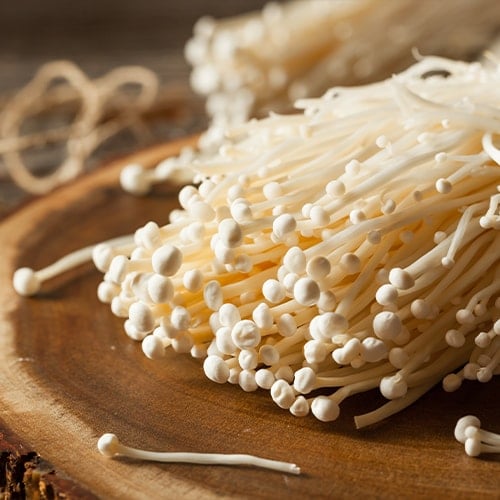
Also known as enokitake, enokidake, or golden needle mushrooms, enoki mushrooms (Flammulina filiformis) are a type of mushroom with long, thin white stems and small caps. These mushrooms have a slightly crunchy texture and a subtly sweet flavor that can be easily overpowered by stronger ingredients. A popular choice in Asian cuisine, enoki mushrooms are commonly used in soups, salads, stir-fries, and hot pots. They add a unique visual appeal and delicate taste to an array of menu selections.
- What Do Enoki Mushrooms Look Like? Grow in tight clusters and have long, thin stems with small white caps
- What Do Enoki Mushrooms Taste Like? Delicate, earthy, slightly sweet, and nutty with a slightly fruity aroma
- How to Use Enoki Mushrooms: In Japanese, Chinese, and Korean dishes, for hot pots, stir-fries, soups, and salads
- How to Clean Enoki Mushrooms: Trim off the root end and separate the individual strands. Gently rinse under cold running water to remove any dirt or debris. Pat them dry with a paper towel.
Back to Top
7. Porcini Mushrooms
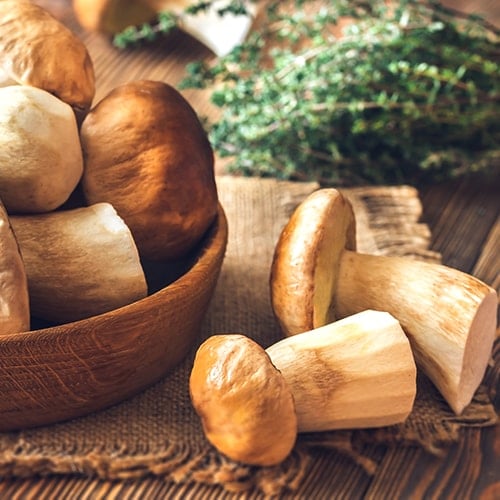
Porcini mushrooms (Boletus edulis), also known as king boletes or penny bun mushrooms, are characterized by their large, thick caps and creamy white stems. Commonly found in Europe and North America, porcini mushrooms are highly sought after in the culinary world for their rich, nutty flavor. Their meaty texture adds a satisfying bite to any dish, making them an excellent substitute for meat in vegetarian and vegan recipes. Try sauteing porcini mushrooms with garlic and butter, serve them as a side dish, or use them as a topping for grilled meats and vegetables.
- What Do Porcini Mushrooms Look Like? Thick stem and a slightly convex-shaped cap that can range in color from light brown to dark brown
- What Do Porcini Mushrooms Taste Like? Nutty, earthy, and slightly fruity with a meaty texture
- How to Use Porcini Mushrooms: Sauteed for toppings and sides, dried for seasonings, or used as a base for broths
- How to Clean Porcini Mushrooms: Cut off the base of the stem. Brush off any dirt or debris with a soft brush or a damp paper towel. Gently cut the cap from the stem and wipe away any remaining dirt.
8. Shiitake Mushrooms
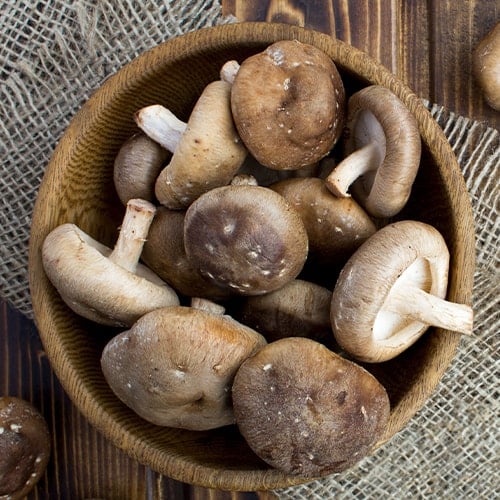
Shiitake mushrooms (Lentinula edodes) are native to East Asia and are a staple in Asian cuisine for their rich, savory flavor. They have a distinctive umbrella-shaped cap and a meaty texture with a unique aroma that is often described as earthy, smoky, and slightly sweet. The aroma intensifies when cooked, adding robust depth to dishes. Shiitakes are known for their umami taste, making them a potent ingredient in soups, stir-fries, and sauces. Used as a popular choice for vegetarian menu options, they can be stuffed with various ingredients such as cheese, breadcrumbs, and herbs for a crowd-pleasing hors d'oeuvre.
- What Do Shiitake Mushrooms Look Like? Convex or umbrella-shaped cap with a smooth, dark brown to black color
- What Do Shiitake Mushrooms Taste Like? Savory and meaty with a rich umami flavor
- How to Use Shiitake Mushrooms: Stuffed mushroom caps, sauteed for sides, toppings, and soups
- How to Clean Shiitake Mushrooms: Brush off any dirt with a damp paper towel. Rinse if needed and quickly dry to prevent water logging. Cut off the tough stems before cooking.
Shiitake Mushrooms vs White Mushrooms
While similar in appearance with large round caps, the difference between shiitake mushrooms and white mushrooms is in their flavor. Shiitake mushrooms are known for their rich, earthy flavor and meaty texture, making them a popular choice for enhancing umami in dishes, particularly in Asian cuisine. Portobello mushrooms, also known as white mushrooms, have a mild flavor, allowing them to be used in a wide range of culinary applications. While shiitake mushrooms are sought after for their distinct taste, portobello mushrooms offer flexibility and adaptability in various recipes.
9. Beech Mushrooms
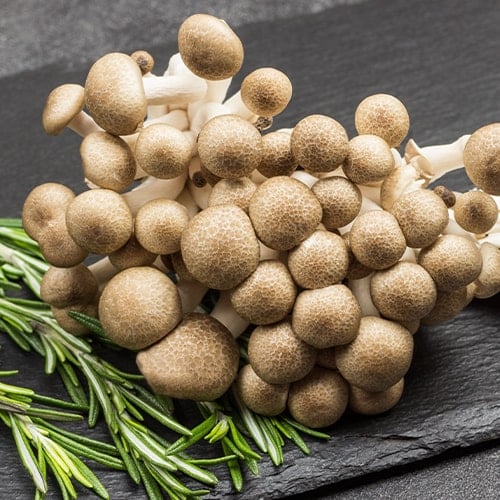
Beech mushrooms (Hypsizygus tessulatus), also known as shimeji mushrooms or clamshell mushrooms, are delicate fungi prized for their nutty and slightly sweet flavor profile. They are characterized by their small, slender stems and petite, button-like caps. Beech mushrooms grow in clusters, with the caps tightly packed together. These mushrooms are native to East Asia and are available in both white and brown varieties (with the white variety having a milder flavor compared to the more robust brown variety). The flavor profile of beech mushrooms can be described as mild, nutty, and slightly sweet. When cooked, these mushrooms develop a rich umami taste, which enhances the overall flavor of stir-fries, soups, and noodle dishes.
- What Do Beech Mushrooms Look Like? Small button-like caps that are creamy white to light brown with thin and tender stems
- What Do Beech Mushrooms Taste Like? Nutty and slightly sweet, earthy umami becomes pronounced when cooked
- How to Use Beech Mushrooms: Stir-fries, soups, stews, adds texture to salads and rice dishes
- How to Clean Beech Mushrooms: Trim off the bottom and break into smaller clusters. Quickly rinse under cold water and pat dry with a paper towel or kitchen towel.
Beech Mushrooms vs Enoki
Beech mushrooms and enoki mushrooms both grow in clusters and have thin stems with button-like caps. The difference between beech mushrooms and enoki mushrooms is in their flavor and size. Beech mushrooms, also known as shimeji mushrooms, have a firm texture and a nutty flavor that holds up well in stir-fries and soups. On the other hand, enoki mushrooms are delicate with long, thin stems and a mild taste, making them ideal for garnishing dishes like salads and sushi.
10. Maitake Mushrooms
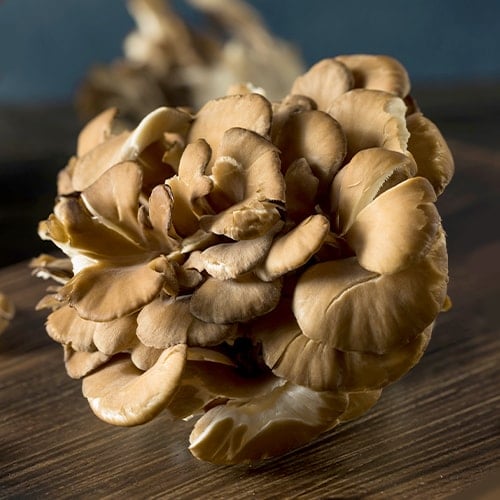
Maitake mushrooms (Grifola frondosa), also known as hen-of-the-woods, are characterized by their overlapping, fan-shaped clusters that resemble the feathers of a hen. These unique mushrooms are native to Japan and North America and have grown in popularity for their meaty texture and rich umami flavor profile. Maitake mushrooms are earthy, nutty, peppery, and slightly bitter, which adds depth and complexity to a wide range of dishes. Add maitake mushrooms as an ingredient in ramen or pho bowls, as a topping on pizza, or as stuffing for chicken with prosciutto.
- What Do Maitake Mushrooms Look Like? Light brown with a distinctive frilly appearance like the feather of a hen’s tail
- What Do Maitake Mushrooms Taste Like? Rich and peppery with nutty and slightly bitter notes
- How to Use Maitake Mushrooms: Sauteed with sesame oil for sides, stir-fried with soy sauce, roasted for toppings on salads and pizzas
- How to Clean Maitake Mushrooms: Brush off any visible dirt. Wipe with a damp cloth or give them a quick rinse. Trim away any damaged or discolored edges.
Maitake Mushroom vs Oyster Mushroom
Maitake mushrooms and oyster mushrooms are similar in appearance, having a fan-like shape and light tan color. The difference between maitake and oyster mushrooms is that oyster mushrooms are smaller and have a mild and delicate flavor, while maitake mushrooms grow in large clusters and have a rich and peppery flavor.
11. Truffle Mushrooms
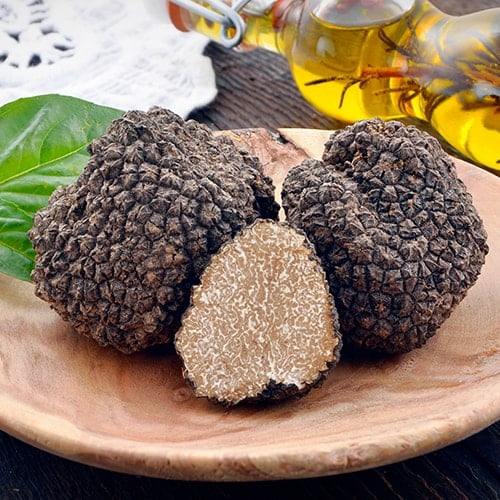
While technically not a mushroom, truffles are spores from the Tuberaceae fungi. They have a rough, knobby exterior that ranges in color from black (Tuber melanosporum) to white (Tuber magnatum), resembling lumps of soil or rocks. Because truffles grow underground, they must be harvested with the help of trained dogs or pigs, making them a luxury ingredient to add to dishes. Known for their strong musky aroma and rich, savory taste, truffle mushrooms are a favorite among chefs and food enthusiasts looking to elevate the flavor of their dishes. Due to their high cost and limited availability, truffle mushrooms are considered a delicacy in the culinary world.
- What Do Truffle Mushrooms Look Like? Small, round, and irregularly shaped with a rough, bumpy exterior ranging in color from black to white
- What Do Truffle Mushrooms Taste Like? Earthy and savory with a strong musky aroma that becomes pronounced when shaved or warmed
- How to Use Truffle Mushrooms: Shaved or grated over pasta, risotto, or scrambled eggs; infused in oil, salt, honey, and butter to impart flavor to other dishes
- How to Clean Truffle Mushrooms: Gently brush off any dirt or debris with a soft brush or cloth. Rinse under cold running water. Do not soak.
12. Lobster Mushrooms
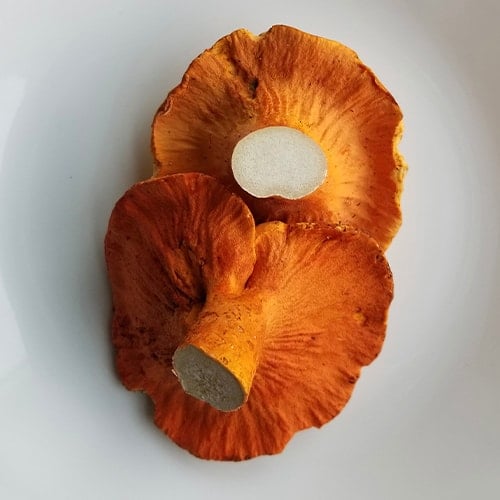
Lobster mushrooms (Hypomyces lactifluorum) are known for their vibrant red appearance and savory flavor profile. These mushrooms are not a distinct species but rather a parasitic fungus that grows on certain species of mushrooms, transforming them into a red lobster-like color. Lobster mushrooms have a firm texture and a taste reminiscent of seafood, making them a popular choice for adding depth to dishes such as soups, sauces, and risotto. With their eye-catching appearance and robust briny flavor, lobster mushrooms are versatile for plant-based recipes like vegan lobster rolls, mushroom bisque, and vegetarian ceviche.
- What Do Lobster Mushrooms Look Like? Vibrant red-orange exterior that resembles the shell of a cooked lobster
- What Do Lobster Mushrooms Taste Like? Rich, earthy flavor, firm and meaty texture with a seafood-like aroma when cut
- How to Use Lobster Mushrooms: Plant-based substitute for lobster in vegan and vegetarian recipes like soups, tacos, ceviche, sandwiches, and pasta dishes
- How to Clean Lobster Mushrooms: Use a dry brush or cloth to remove any dirt. Do not wash or soak, which can remove the distinct red coloring. Cut off brown spots and stem bases.
13. Black Trumpet Mushrooms
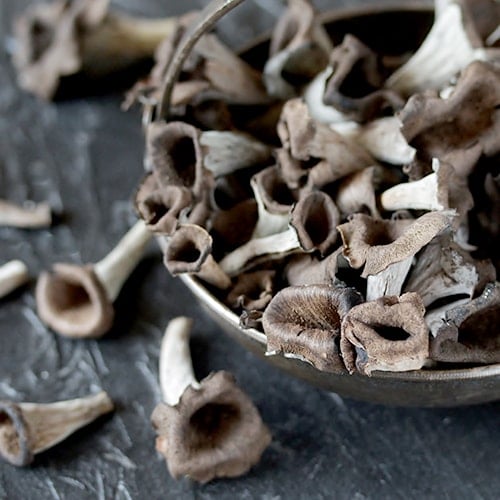
Black trumpet mushrooms (Craterellus cornucopioides), also known as horn of plenty or trumpet of death, feature dark black trumpet-shaped caps and are hollow and vase-like in shape. They have a rich and earthy flavor, which is often described as smoky or nutty. Black trumpet mushrooms also have a delicate and tender texture, which adds a pleasant mouthfeel to any dish they are used in. Their flavor profile and texture make them a great addition to salads, soups, stews, risotto, and pasta dishes. They can also be sauteed or roasted and used as a topping for pizzas or incorporated into sauces and gravies.
- What Do Black Trumpet Mushrooms Look Like? Hollow and vase-like, dark black or brown trumpet-shaped caps that curl outwards
- What Do Black Trumpet Mushrooms Taste Like? Nutty, smoky, and earthy with a deep umami flavor and light fruity aroma
- How to Use Black Trumpet Mushrooms: Pan-seared with garlic and butter, made into sauce for seafood, roasted for pizza toppings
- How to Clean Black Trumpet Mushrooms: Split the mushroom and rinse the outside and inside with cold running water. Pat dry with a towel or gently spin in a salad spinner to dry.
Back to Top
Mushroom FAQs
Here are some of the most common questions when it comes to using mushrooms in culinary applications:
Can You Freeze Mushrooms?
Mushrooms can be frozen to extend their shelf life, but freezing can change their texture and waterlog them. It is best to freeze mushrooms that have been cooked or blanched to preserve their flavor and minimize texture changes. Frozen mushrooms can be used in soups, sauces, and other cooked dishes for added convenience.
How to Store Mushrooms
Store fresh mushrooms in a paper bag in the refrigerator for up to one week. Avoid washing mushrooms before storing them, as moisture can lead to quicker spoilage. Mushrooms should be used within a few days of purchase for the best taste and texture.
How Long Are Mushrooms Good For?
When stored in a paper bag in the refrigerator, most varieties of mushrooms can last for up to 7 days. Morels and chanterelles typically have a shorter shelf life of about 3-4 days. To extend the lifespan of mushrooms, avoid washing them until you are ready to use them and store them in a cool, dry place.
Should You Wash Mushrooms?
While some chefs prefer not to wash mushrooms as they can absorb water and lose flavor, others advocate for a quick rinse to remove any dirt or debris. Ultimately, the decision to wash mushrooms depends on the specific variety and intended use. Delicate mushrooms like lobster mushrooms should be gently brushed clean, while heartier varieties such as portobellos can withstand a quick rinse. It is important to dry mushrooms thoroughly after washing to prevent them from becoming waterlogged during cooking.
Edible Mushrooms Chart
From the earthy richness of portobello mushrooms to the delicate sweetness of enoki mushrooms, there is a mushroom to suit every dish. Whether you're looking to add depth to a sauce, create a vegan entree, or simply enhance the umami profile of your dishes, mushrooms are a versatile ingredient that can elevate your culinary creations.



